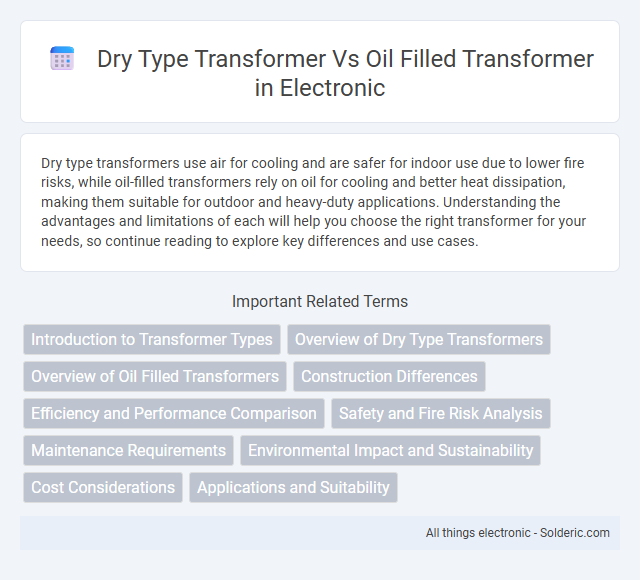Dry type transformers use air for cooling and are safer for indoor use due to lower fire risks, while oil-filled transformers rely on oil for cooling and better heat dissipation, making them suitable for outdoor and heavy-duty applications. Understanding the advantages and limitations of each will help you choose the right transformer for your needs, so continue reading to explore key differences and use cases.
Comparison Table
| Feature | Dry Type Transformer | Oil Filled Transformer |
|---|---|---|
| Cooling Medium | Air (Natural or Forced) | Mineral or Synthetic Oil |
| Fire Risk | Low | High |
| Maintenance | Low | Higher (Oil Testing & Replacement) |
| Environmental Impact | Eco-friendly, Non-toxic | Potential Oil Leaks, Pollution Risk |
| Installation | Indoor & Outdoor (Limited Outdoor Use) | Primarily Outdoor |
| Insulation | Epoxy Resin or Air | Oil |
| Size & Weight | Bulkier, Heavier | Compact for Same Rating |
| Cost | Higher Initial Cost | Lower Initial Cost |
| Application | Hospitals, Commercial Buildings, Indoor Use | Power Stations, Industrial, Outdoor Use |
| Lifetime | Typically 20-25 years | Typically 30-40 years |
Introduction to Transformer Types
Dry type transformers use air for cooling and are filled with epoxy resin, ensuring enhanced fire safety and lower maintenance than oil filled transformers, which utilize mineral oil as an insulating and cooling medium. Oil filled transformers offer better heat dissipation and higher efficiency in heavy-duty applications, but they require careful handling due to the risk of oil leaks and fire hazards. Both types are essential in power distribution, with dry type transformers preferred in indoor or environmentally sensitive areas, while oil filled transformers dominate outdoor and high-capacity installations.
Overview of Dry Type Transformers
Dry type transformers use air as a cooling medium and typically feature solid insulation systems, making them safer for indoor applications due to reduced fire risks. Their maintenance requirements are lower compared to oil filled transformers, which rely on mineral or synthetic oil for cooling and insulation but pose higher environmental and safety hazards. Your choice between the two should consider factors such as installation environment, fire safety regulations, and maintenance capabilities.
Overview of Oil Filled Transformers
Oil filled transformers use mineral oil as a cooling and insulating medium, providing efficient heat dissipation and electrical insulation. These transformers are preferred in high voltage and heavy-duty applications due to superior thermal management and longer service life compared to dry type transformers. The oil also enhances the transformer's ability to handle overloads and maintain stable performance in harsh environmental conditions.
Construction Differences
Dry type transformers feature an air-cooled design with windings encapsulated in resin or varnish, eliminating the need for oil-filled insulation. Oil-filled transformers use mineral or synthetic oil as both coolant and insulator, requiring sealed tanks and cooling radiators for heat dissipation. The construction of dry type transformers enhances fire safety and maintenance simplicity, while oil-filled transformers offer higher efficiency in heat management for larger capacities.
Efficiency and Performance Comparison
Dry type transformers typically offer higher efficiency in environments requiring minimal maintenance and reduced fire risk, thanks to their air-cooled design that limits energy loss. Oil-filled transformers excel in performance under high load conditions due to superior insulation and cooling properties of oil, which maintain stable temperatures and enhance lifespan. Efficiency varies with application demands; dry transformers are optimal for indoor or sensitive settings, while oil-filled transformers perform best in heavy-duty, outdoor scenarios.
Safety and Fire Risk Analysis
Dry type transformers offer enhanced safety with significantly lower fire risk due to their use of air or epoxy resin insulation instead of combustible oil. Oil-filled transformers, while efficient in cooling, pose higher fire hazards because leaking oil can ignite under electrical faults or overheating. Your facility's safety protocols should consider dry type transformers in environments where minimizing fire risk is critical.
Maintenance Requirements
Dry type transformers require less maintenance due to the absence of oil, eliminating the need for oil testing and minimizing risks of leaks or fire hazards. Oil-filled transformers demand regular oil sampling and testing to monitor moisture, acidity, and dielectric strength, which are crucial for ensuring operational reliability. Routine inspections, including checking for oil leaks and oil level adjustments, are vital to prevent insulation breakdown and extend the transformer's lifespan.
Environmental Impact and Sustainability
Dry type transformers offer a significant environmental advantage over oil-filled transformers by eliminating the risk of oil leaks and spills that can contaminate soil and water sources. These transformers use air or other non-flammable insulation materials, resulting in lower fire hazards and easier disposal, making them a more sustainable choice for eco-sensitive areas. Your decision to select dry type transformers supports long-term environmental sustainability and reduces the ecological footprint associated with transformer maintenance and operation.
Cost Considerations
Dry type transformers generally have higher upfront costs compared to oil-filled transformers due to their complex insulation materials and manufacturing processes. Oil-filled transformers benefit from better cooling efficiency, which can reduce long-term operational expenses, but they require regular maintenance and oil monitoring, adding to maintenance costs. When evaluating your investment, consider that dry type transformers offer lower fire risk and maintenance needs, potentially leading to cost savings over the product lifecycle.
Applications and Suitability
Dry type transformers are ideal for indoor applications such as commercial buildings, hospitals, and schools due to their enhanced safety, minimal maintenance, and reduced fire risk. Oil-filled transformers suit outdoor and heavy industrial environments where higher power ratings and superior cooling efficiency are required. The choice depends on factors like installation location, cooling needs, fire safety regulations, and environmental considerations.
dry type transformer vs oil filled transformer Infographic

 solderic.com
solderic.com